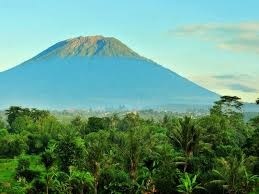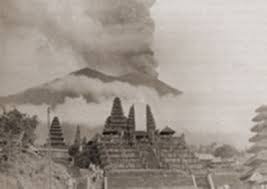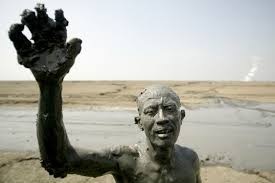“Whew, It’s Getting A Little Warm!” The Ups, And Downs Of Living On The Ring Of Fire.
Its 8.00 am on a Friday morning here in Bali and, as usual, at this time of year the weather is picture perfect with not a cloud in the sky. A light breeze, soft as gossamer wafts across the terrace, taking the sting out of the morning heat.
Just Forty- seven kilometers away things are perhaps not so peaceful as farmers in the villages scramble to move their livestock off the slopes of the highest peak on the island, Mt. Agung.

Mount Agung or Gunung Agun is the highest point on Bali. At 12,500 ft. it is a spectacular structure which dominates the surrounding area peppered as it is with impossibly green rice terraces that tumble down its slopes. Its position, on the eastern edge of the island means it influences the climate to the west bringing abundant rain to those self same terraces.

The Balinese believe that Mt Agung is a replica of Mt Meru, the central axis of the universe. One of the many legends holds that the mountain is a fragment of Meru brought to Bali by the first Hindus.
Clinging precariously high on the slopes of the mountain is the most important temple on Bali, Pura Besakih or the ‘mother temple’ which every Balinese resident visits at least twice a year.

Gunung Agung last erupted over fifty years ago and has, since that time ‘been asleep’;
That is until now.
On February 18, 1963, local residents heard a series of loud explosions and saw clouds rising from the crater of the mountain. On February 24, lava began flowing down the northern slopes traveling over 7 km down the side of the mountain over the next 20 days,

At that point the mountain went ‘quiet.’
Many of the local inhabitants, believing that Agung had completed its eruption cycle slowly drifted back to their villages, farms and businesses.
How wrong they were!
On March 17, without warning, the volcano erupted once again sending debris 8 to 10 km into the atmosphere and, if that wasn’t enough then generated massive pyroclastic flows swallowing scores of villages, and taking the lives of over 1,500 inhabitants Two days later, cold Lahars ( mud flows) caused by heavy rainfall after the eruption killed an additional 200.

A period of relative calm then ensued for a period of two months before a second, and far more violent eruption occurred on May 16, accompanied once again by massive pyroclastic flows that killed another 300 inhabitants.
Numerous Manku’s (Balinese priests ) headed to the mountain to offer up prayers and sacrifices, often standing directly in the path of the approaching lava.
Miraculously, the lava flows missed, by just a few yards, the sacred Mother Temple of Besakih. The saving of the temple is still regarded by Balinese as a signal from the gods as a demonstration their power but also to show their compassion by not destroying the temple that been erected to praise the mountain that was doing its level best to destroy it.

Bali is just one of the seventeen thousand islands that make up the archipelago that is Indonesia. The country frequently experiences violent earthquakes and volcanic eruptions as it lies near an intersection of shifting tectonic plates, including the Pacific plate, Eurasian plate, Australian and Philippine plate.
It is one of the most seismically active zones on earth, with more active volcanoes than any other country on earth (136) including some of the world's most famous volcanoes, Krakatau (Krakatoa), Tambora, and Merapi.
Powerful earthquakes are a common occurrence here as typified by two powerful quakes in March 2005 and May 2006 taking the lives of thousands of people in the regions where they occurred.

Just sixteen years ago, on December 26th 2004, more than 220,000 people in Indonesia perished or classified as missing after a powerful undersea earthquake, off the large island of Sumatra generated a powerful tsunami. This giant wave then travelled over 12, 000 miles across the Indian Ocean devastating communities as far afield as Thailand, India, Sri Lanka and Somalia.
Indonesia’s largest ever eruption however was the explosive eruption of Mt. Tambora on the island of Sumbawa in 1815 and remains the greatest eruption in recorded history. The explosion was heard more than 2000 Km away in Australia and, this deadly event killed over 71,000 people! Starvation and disease was the cause of most of the deaths, as the eruptive fallout ruined agricultural production in the region and across most of the archipelago.

The devastation wasn’t limited to just Indonesia as the ash cloud caused global climate anomalies, including a volcanic winter’ phenomenon. The year 1816 has become known as “the year without a summer’ because of the eruption's effect on North American and European weather. Crops failed and livestock died in much of the Northern Hemisphere, triggering the worst famine of the 19th century.

The National gallery in London has a wonderful collection of Turner and Constable paintings showing London experiencing spectacular sunsets that have never been seen since. These sunsets were of course created by the tons of dust and ash in the atmosphere, courtesy of Mt Tambora. Sunlight that penetrated the haze created a magical kaleidoscope of vibrant hues bathing the city in light made up of all of the colours in the spectrum
And so, on this morning when the world seems calm, just over the hills a giant mountain wheezes, rumbles and belches like a bellicose politician, threatening to disgorge countless tons of lava and ash. Perhaps, this sacred mountain is simply rolling over in its sleep but, perhaps not as it might have woken up in a foul mood and will roar once more.
In the interim, we simply have to wait and see what nature will do, for it is a lot more powerful than us mere mortals.

Now that that’s written, I think I’ll have a nap!!
Paul v Walters is the best selling author of several novels and when he is not cocooned in sloth and procrastination in his house in Bali, he scribbles for several leading travel and vox pop journals around the globe. His latest offering, Asset, should be released in early 2018.
""""""""""
Artikel dari Paul Walters
Lihat blog
I have always subscribed to the notion that the 'even' years are better than the odd ones. Good thin ...

In the last few days, I came across a somewhat tongue in cheek article in The Guardian written by th ...

Ignorance, thankfully, is something that we can cure. Stupidity, on the other hand, is terminal. · F ...
Profesional terkait
Anda mungkin tertarik dengan pekerjaan ini
-

HRGA Manager
Ditemukan di: beBee S2 ID - 6 hari yang lalu
RGF HR Agent Recruitment indonesia - bali, Indonesia Permanent◆ Retain and maintain regulation/business permission of the Company respective entities◆ *Arrangement to get the Permit such as PBG, SLF, related Hotel operation etc.◆ Reporting to various stakeholders including shareholders meeting◆ Maintain corporate assets◆ Establish and maint ...
-

Branch Manager
Ditemukan di: beBee S2 ID - 6 hari yang lalu
RGF HR Agent Recruitment indonesia - bali, Indonesia Permanent- Develop a branch team from scratch- Lead branch members to achieve targets- Make a strategy for the branch area- Report daily, weekly, and monthly achievements- Other task as assigned Mengembangkan tim cabang dari awal- Memimpin anggota cabang untuk mencapai target- Membuat str ...
-

Research and Projects Specialist
Ditemukan di: beBee S2 ID - 1 hari yang lalu
RGF HR Agent Recruitment indonesia - jakarta, Indonesia Permanent1. Gathering related information on law, regulation, and anything beneficial for strategic analysis of existing project and developing new geothermal business. 2. Supporting Management- Attending the meeting- Making report- Analyzing, reviewing, and modifying economic model- Anal ...

Komentar
Lisa Gallagher
6 tahun yang lalu #21
Paul Walters
6 tahun yang lalu #20
Stephanie Brookes I think I will resort to a wet towel wrapped around my head!
Stephanie Brookes
6 tahun yang lalu #19
Paul Walters
6 tahun yang lalu #18
Randall Burns . I shall keep you posted
David B. Grinberg
6 tahun yang lalu #17
Randall Burns
6 tahun yang lalu #16
CityVP Manjit
6 tahun yang lalu #15
Paul Walters
6 tahun yang lalu #14
Netta Virtanen . Ill keep you posted!!
Paul Walters
6 tahun yang lalu #13
Debasish Majumder . Thank you as always
Ian Weinberg
6 tahun yang lalu #12
😂
Paul Walters
6 tahun yang lalu #11
Ken Boddie Duly noted Ken especially the G 7 T bit !!
Ken Boddie
6 tahun yang lalu #10
Debasish Majumder
6 tahun yang lalu #9
Gert Scholtz
6 tahun yang lalu #8
Pascal Derrien
6 tahun yang lalu #7
Ian Weinberg
6 tahun yang lalu #6
Ali Anani
6 tahun yang lalu #5
Paul Walters
6 tahun yang lalu #4
Paul Walters
6 tahun yang lalu #3
Paul Walters
6 tahun yang lalu #2
Paul Walters
6 tahun yang lalu #1